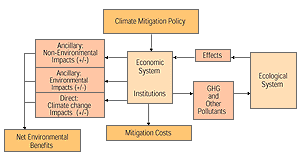7.2.2.3 Ancillary Benefits and Costs and Co-benefits and Costs

Figure 7.1: Mechanism for the Generation of Ancillary Impacts. Please
note that climate change impacts are not discussed in this report, but in
the Third Assessment Report of Working Group II. |
The literature uses a number of terms to depict the associated
benefits and costs that arise in conjunction with GHG mitigation policies. These
include co-benefits, ancillary benefits, side benefits, secondary benefits,
collateral benefits, and associated benefits. In the current discussion, the
term “co-benefits” refers to the non-climate benefits of GHG mitigation
policies that are explicitly incorporated into the initial creation of mitigation
policies. Thus, the term co-benefits reflects that most policies designed to
address GHG mitigation also have other, often at least equally important, rationales
involved at the inception of these policies (e.g., related to objectives of
development, sustainability, and equity). In contrast, the term ancillary benefits
connotes those secondary or side effects of climate change mitigation policies
on problems that arise subsequent to any proposed GHG mitigation policies. These
include reductions in local and regional air pollution associated with the reduction
of fossil fuels, and indirect effects on issues such as transportation, agriculture,
land use practices, employment, and fuel security. Sometimes these benefits
are referred to as “ancillary impacts”, to reflect that in some cases
the benefits may be negative. From the perspective of policies to abate local
air pollution, GHG mitigation may be an ancillary benefit.
Figure 7.1 illustrates the generation of ancillary benefits
to GHG emission reduction policies.4
These policies operate through the economic and institutional system within
a country and lead to reductions in GHGs, changes in other pollutants, and mitigation
costs. Changes in GHG emissions in turn lead to changes in air and water pollution,
which ultimately extend throughout the environment and feed back into the economy.
Then, depending on baseline conditions, technologies, and institutions, such
as labour markets, tax systems, and existing environmental and other types of
regulations (represented by “institutions” in the economic system
box), these feedbacks may become:
- environmental impacts (such as the value of changes in conventional air
or water pollution);
- non-environmental impacts (such as the value of employment effects); and,
- direct climate change impacts.
There appear to be three classes of literature regarding the costs and benefits
of climate change mitigation:
- literature that primarily looks at climate change mitigation, but that
recognizes there may be benefits in other areas;
- literature that primarily focuses on other areas, such as air pollution
control, and recognizes there may be benefits in the area of climate mitigation;
and
- literature that looks at the combination of policy objectives (climate
change and other areas) and looks at the costs and benefits from an integrated
perspective.
Each of these classes of literature may have their own preferred terms, and
for class (3) it seems to be “co-benefits”. TAR acknowledges the relevance
of all three, yet specifically wants to make the case for an integrated approach,
linking climate change mitigation to the achievement of sustainable development
and other policy objectives. Therefore, in this report, the term “co-benefits”
is used only when speaking generically about the issue because of the limited
availability of literature. The term “ancillary benefits” is used
when addressing class (1) and (2) literature. Class (1) literature appears to
be the most extensive; it is this literature on the ancillary benefits of climate
change mitigation that is primarily covered in this section.
The discussion of ancillary impacts and/or co-benefits and costs, and the estimation
of these are closely related to the concept of external cost, which is discussed
below.
|